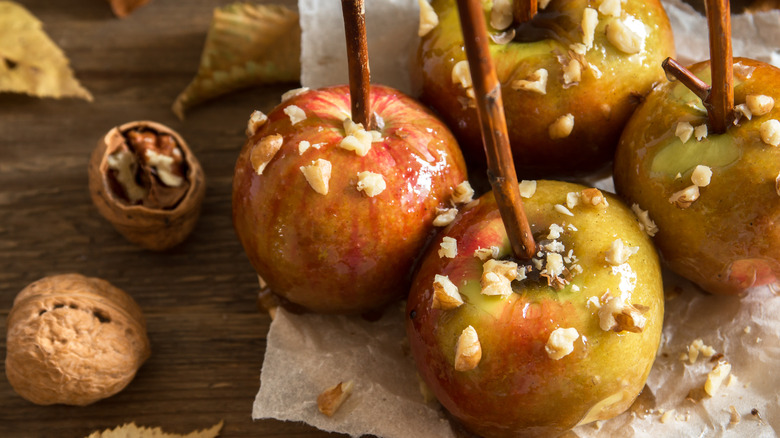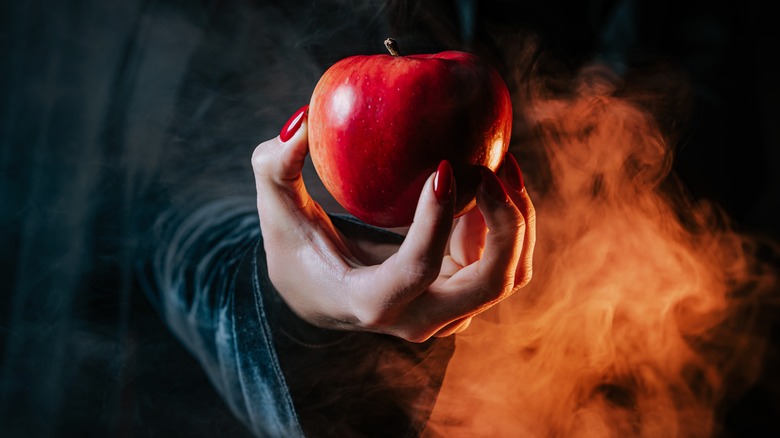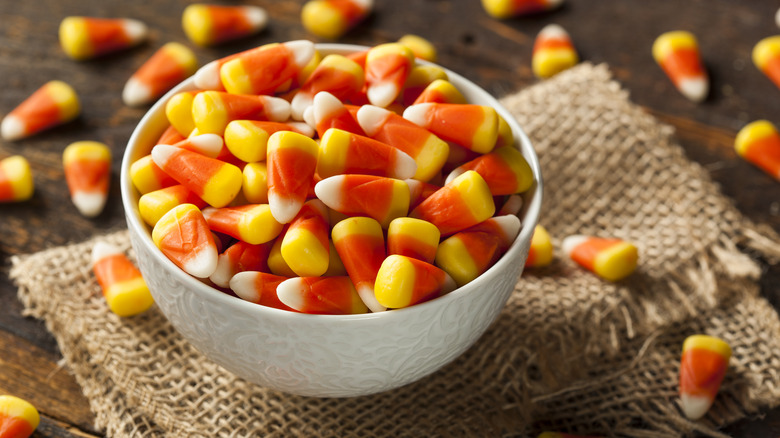Here's What Americans Ate On Halloween In The 1800s
Halloween in the 1800s was not the candy-fueled celebration we know today. Its history stretches back to the times of Celtic druids and Roman conquests, and the foods that Victorian-era Americans enjoyed for Halloween were shaped by ancient European customs. These traditions were adapted to the native and seasonal foods of a new country, resulting in Halloween fare such as soul cakes, apples, nuts, colcannon, barmbrack bread, and candy corn.
Back in ancient Ireland, the Samhain harvest ritual marked both the Celtic New Year and the beginning of winter — a time believed to be when the veil between the living and the dead was at its thinnest. As the Roman Catholic Church spread through Europe, the pagan Samhain festival was absorbed into the Christian observances of All Souls' Day and All Saints' Day. When Irish families immigrated to America during the Great Famine of the mid-1800s, they brought Halloween and its associated foods and traditions with them.
One such tradition was the baking of soul cakes. These cakes, thought to have been baked in ritual Samhain bonfires, were later sanctioned by the Church. Poor children would go door to door, begging for cakes in exchange for prayers for the deceased, a practice that eventually evolved into trick-or-treating. Sometimes marked with a cross, these cakes symbolized the release of souls from purgatory. Similar to shortbread cookies or biscuits, these plain cakes were sweetened with fruit and sugar, and sometimes spiced with cinnamon.
Halloween feasting in the 1800s
In the 1800s, Americans observed the British Halloween tradition of Snap Apple Night. Young people were blindfolded and bound, and then they would attempt to bite apples that were suspended from strings. Those who succeeded were said to be next in line to find a mate. Another version had apples submerged in water buckets — an activity known today as bobbing for apples. Apples were also made into apple butter, ale, and cider, and glazed with sweet syrup, a precursor to candied apples.
Nuts were another fixture of Victorian American Halloween, serving both as food and for fortune-telling. Nut Crack Night involved naming nuts after romantic interests and then throwing them into a fire. An exploded or cracked nut signified that its namesake was not a suitable match, while a nut that burned to ash foretold a future spouse. Chestnuts, peanuts, and hazelnuts were enjoyed roasted and glazed. In one form of divination, women would eat a treat made of walnuts, hazelnuts, sugar, and nutmeg before bed to dream of whom they would marry.
Candy corn is older than you think
Another food the Irish brought with them to the United States was colcannon. Although this mashed potato dish is often associated with St. Patrick's Day, it was traditionally served at Halloween in Ireland, a custom that continued in America. A staple of Irish cuisine and rich in history, colcannon is made with potatoes, butter or cream, cabbage or kale, and scallions.
Irish barmbrack, a sweet bread, was also meant to foretell the future. Similar to Christmas fruitcake, it included dried fruits, usually raisins, and charms baked into it. The trinket you received in your slice symbolized an omen for the future; a ring signified marriage, while coins indicated prosperity. Food divination made its way into American Halloween traditions via Scottish dumb cakes as well. Its simple recipe required following an elaborate ritual , including cooking in silence. Women would eat it before sleep to dream of their future spouse's name.
Today, candy corn is synonymous with Halloween, but its invention dates back to the 1880s. First produced by the Wunderlee Candy Company of Philadelphia (later bought by Jelly Belly), the recipe has remained largely unchanged, with the official candy corn flavors coming from a blend of marshmallow, fondant, and vanilla. Though packaged candies didn't come into vogue until the early 20th century, candy corn remains a stalwart Halloween confection, serving as a link back to how the holiday was celebrated in America nearly 150 years ago.



